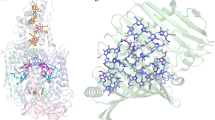Abstract
Light sensing in organisms is conferred by a small number of light-absorbing, organic molecules. The primary light reaction is transmitted to the protein moiety, which in turn triggers cellular reactions. In filamentous fungi a large number of different morphogenetic and physiological processes is controlled by light; flavine- and tetrapyrrol-containing photoreceptors are main players.
Similar content being viewed by others
Literatur
Rodriguez-Romero J, Hedtke M, Kastner C et al. (2010) Fungi, hidden in soil or up in the air: light makes a difference. Annu Rev Microbiol 64:585–610
Blumenstein A, Vienken K, Tasler R et al. (2005) The Aspergillus nidulans phytochrome FphA represses sexual development in red light. Curr Biol 15:1833–1838
Brandt S, von Stetten D, Bünther M et al. (2008) The fungal phytochrome FphA from Aspergillus nidulans. J Biol Chem 283:34605–34614
Froehlich AC, Liu Y, Loros JJ et al. (2002) White collar-1, a circadian blue light photoreceptor, binding to the frequency promoter. Science 297:815–819
Malzahn E, Ciprianidis S, Káldi K et al. (2010) Photoadaptation in Neurospora by competitive interaction of activating and inhibitory LOV domains. Cell 142:762–772
Bayram Ö, Biesemann C, Krappmann S et al. (2008). More than a repair enzyme: Aspergillus nidulans photolyse-like CryA is a regulator of sexual development. Mol Biol Cell 19:3254–3262
Ruger-Herreros C, Rodríguez-Romero J, Fernández-Barranco R et al. (2011) Regulation of conidiation by light in Aspergillus nidulans. Genetics 188:809–822
Purschwitz J, Müller S, Kastner C et al. (2008) Functional and physical interaction of blue and red-light sensors in Aspergillus nidulans. Curr Biol 18:255–259
Baker CL, Loros JJ, Dunlap JC (2012) The circadian clock of Neurospora crassa. FEMS Microbiol Rev 36:95–110
Bayram O, Krappmann S, Ni M et al. (2008) VelB/VeA/LaeA complex coordinates light signal with fungal development and secondary metabolism. Science 320:1504–1506
Nützmann HW, Reyes-Dominguez Y, Scherlach K et al. (2011) Bacteria-induced natural product formation in the fungus Aspergillus nidulans requires Saga/Ada-mediated histone acetylation. Proc Natl Acad Sci USA 108:14282–14287
Purschwitz J, Müller S, Kastner C et al. (2006) Seeing the rainbow: light sensing in fungi. Curr Opin Microbiol 9:566–571
Author information
Authors and Affiliations
Corresponding author
Additional information
Reinhard Fischer Jahrgang 1962. Biologiestudium an der Universität Marburg. 1987–1990 Promotion bei Prof. Dr. Thauer, Max-Planck-Institut für terrestrische Mikrobiologie, Marburg. 1992–1993 DFG-Postdoc bei Prof. Dr. Timberlake in Athens, GA, USA. 1994–2004 Gruppenleiter an der Universität Marburg und am MPI für terrestrische Mikrobiologie. 1998 Habilitation für Mikrobiologie und Zellbiologie. 2004–2007 C3-rofessur für Mikrobiologie an der Universität Karlsruhe. Seit 2007 W3-Professur Mikrobiologie am Karls ruher Institut für Technologie (KIT).
Julio Rodriguez-Romero Jahrgang 1977. 1996–2001 Biologie-studium an der Universität Sevilla, Spanien. 2007 EMBO-Fellowship an der Universität Glasgow, Schottland. 2008 Promotion (European Doctorate) an der Universität Sevilla. Seit 2009 Postdoc am Karls ruher Institut für Technologie (KIT).
Rights and permissions
About this article
Cite this article
Fischer, R., Rodriguez-Romero, J. Flavin und lineare Tetrapyrrole als Lichtsensoren in Pilzen. Biospektrum 18, 19–21 (2012). https://doi.org/10.1007/s12268-012-0136-5
Published:
Issue Date:
DOI: https://doi.org/10.1007/s12268-012-0136-5




